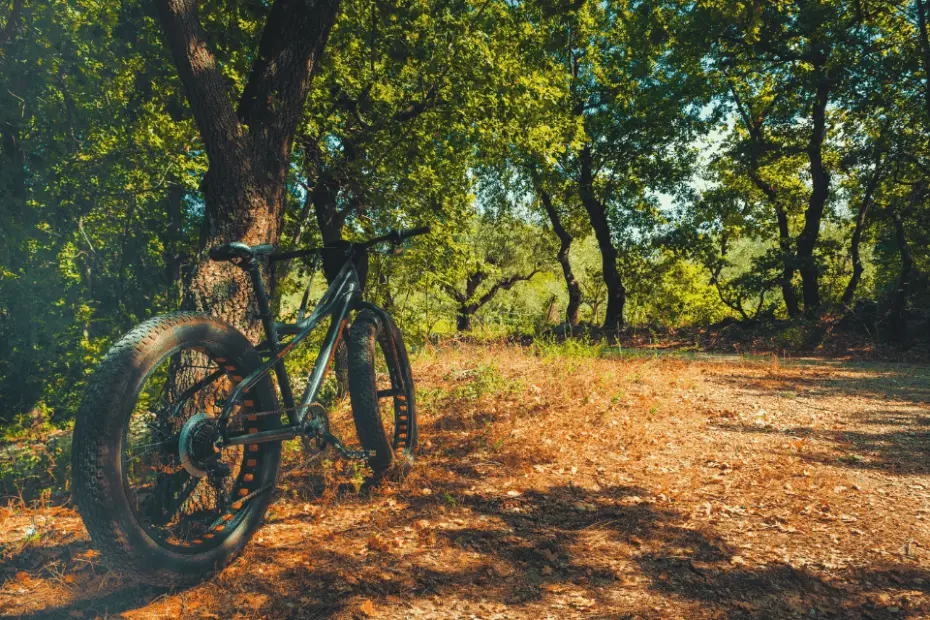As someone who loves to head out into the hills and go flying down some off-road tracks, the one thing I am always wary of is pushing my bike too hard, to the point where I lose grip on the surface. There have been numerous occasions where I or a buddy have had the bike slip out from underneath us when talking a sharp turn on a muddy surface.
Enter the fat tire mountain bike. The super grippy, all-terrain, mud eating machine. I’m not a convert yet, but one of my friend swears by them. So I decided to find out more about them and in this guide, I will cover the pros and cons of fat tire mountain bikes.
For this of you after the headlines and not the full story, here are the main points pros and cons of fat tire mountain bikes:
Pros:
- Easier to ride on softer ground like mud and snow
- Can ride on all terrains
- Less chance of getting punctures
- They are great fun
- Very good at keeping you fit
Cons:
- More expensive that “normal” mointain bikes
- Heavier than other bikes
- Can feel slow and sluggish
- Getting tire pressure right can be hard
- Spare, repairs and upgrades can be expensive
Want to find out more about the pros and cons of fat tire mountain bikes? Then read on.
What is a Fat Tire Mountain Bike?
Fat tire mountain bikes are not like regular mountain bikes. They are designed with larger and wider tires, which allow the rider to ride over any type of terrain without getting stuck in the mud. This has made them a favourite among off-road riders and enthusiasts everywhere.
Typically the tire on these bikes will be 3.5” wide or more, meaning they are significantly wider than a standard mountains bike.
This extra-wide tire needs an extra-wide set of forks and frames to accommodate the extra width. This means that it isn’t simply a matter of sticking wider tires on a standard mountain bike. The frame, forks and most of the components have been specifically designed to fit this bike.
Pros of a Fat Tire Mountain Bike
More Surface Area Make It Easier To Ride On “Soft” Surfaces
There are many factors that play into the success of riding a bike on sand or snow. A rider needs to put enough pressure on their tires so they can push through the surface. They also need to make sure that their tires are wide enough so they don’t sink down as they pedal.
Wider tires typically mean a larger surface area. A larger surface area means that more of your weight is spread, which makes it less likely for the tire to sink into the surface. This is important because you want to avoid sinking into the ground because it will make it harder for you to continue riding your bike and could lead to you being thrown over your handlebars.
All Terrain Vehicle
To have a more enjoyable ride, it is great to go off the beaten path and explore.
There is a lot of time that can be wasted by going on a bike ride just to find out that the road you chose is too wet, too rocky or too muddy.
This is where the fat tire mountain bike really comes into its own.
Fat tire bikes are designed for use on multiple surfaces and can eat up the rocky terrain with ease. Compared to a road bike, this bike means you no longer have to stick to the flatter routes to get home.
Less Chance Of Getting A Puncture
The fat tires are designed for off-road use or to be ridden at lower pressure.
The latter can lead to a reduced risk of punctures. Fat tires come with low rolling resistance and they often have little beads, which makes them less rigid than other types of tires.
This is advantageous because the tire can adapt to the surface better, which means it will not puncture as easily on rough terrain compared to a high-pressure off-road tire or a road tire when it meets a bump in the road.
More Comfortable Than Other Bikes
The fat tire bike is the perfect bike for the casual rider. It’s designed to be more comfortable than a road bike.
Road bikes are built for speed and as a result, they are thin and don’t have any kind of cushioning or suspension.
Because they are built for comfort, fat-tire bikes have low pressure which can help to give some cushioning when riding across rough surfaces.
You won’t feel every little bump in the road like you would with a road bike!
Fat Tire Bikes Are Fun
Not only do fat-tire bikes look cool, but they also perform well when it comes to going fast downhill, due to the extra grip you get from the extra-wide tires.
Whilst some people love road cycling, let’s be honest, heading out into the woods or hills and taking your bike off-road is much more exciting. A fat bike is perfect for this as you don’t have to worry about whether your bike is capable of riding in those conditions because it is!
Great For Keeping You Fit
Fat bikes are a great way to get in shape and stay healthy, especially if you’re looking for something more challenging than traditional cycling.
The extra weight and friction mean you work harder to go faster, which is perfect for those who are looking for a challenge.
You don’t have to be fat to ride a fat bike, and you certainly won’t be if you ride it consistently.
Cons of a Fat Tire Mountain Bike
Fat Bikes Are Expensive
Fat bikes are rare because of their specific design. Compared to standard mountain bikes and road bikes, there are far fewer manufacturers and those that do make them generally have fewer models of fat bikes compared to other bikes.
As with most items, the lower the volume made, the more expensive each component part is to buy as there is no benefit from economies of scale.
Fat Bikes Are Heavier Than Other Bikes
The increase in the width of tires, as well as the increased size of wheels, make fat bikes heavier than traditional bikes. This is because it takes more raw materials to create the wider tires, as well as the larger wheels.
All the components on a Fat Bike are also heavier than those found on a standard mountain bike because they have to bear much more weight.
Slower Than Regular Bikes
Due to them being heavier than regular bikes, fat bikes are slower than regular bikes. Just like with cars, extra weight means you have to put extra energy into making them move, so the added weight of a fat tire bike means you will be slower than on a regular bike when applying a similar level of effort.
They are also slower due to the wider surface area of the tires when riding.
The increased rolling resistance of a fat bike will increase the friction on the road surface. This increase friction will cause your bike to slow down much quicker than a bike with less friction. Again, this means you either have to increase your effort to achieve a similar speed to a road bike, or just accept that you will be slower in general.
Tire Pressure Can Be A Problem
Tire pressure is another problem with fat-tire bikes.
Whilst they are very adaptable for riding on many different surfaces, the pressure in your tires will affect how well you are able to ride on them.
For example, in softer conditions, you will want to have lower tire pressures, this is because it increases the surface area of your wheel and makes it easier to “float” over the surface.
However, this lower tire pressure is not ideal for harder surfaces, as the increased surface area increases the surface area and slows you down.
Taking all of this into consideration can make it difficult to decide on the right tire pressure and makes the process a lot more complicated than it ought to be.
Replacements And Upgrades Are Expensive
Not every bike rider is a fat bike rider. That means that not every bike store has fat bike parts. This is a common problem for the riders of these bikes because you can’t just walk into any store and buy the parts for your bike. The cost of these parts can be quite high as well, due to their specialization, so people have to pay more to get them.
Fat tire bike parts also need to be more durable than regular bike parts due to the fact that fat bikes are heavier. This added durability can make the bike parts more expensive because of the extra time they take to produce and the quality of the materials used.
Summary
So there you go, there are plenty of things to mull over when it comes to the pros and cons of fat tire mountain bikes.
For me, I think the pros are very strong with these bikes, particularly with how fun they are and how cool they look. Whilst they are expensive to buy and repair, with good, regular maintenance, you will have yourself a great time with pretty much every ride.
Maybe think twice about buying one for commuting thought!
If you liked this guide, please share it on Pinterest. Also, please check out our other guides to all things outdoors.
Happy cycling!



